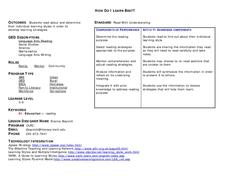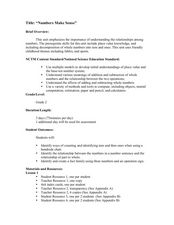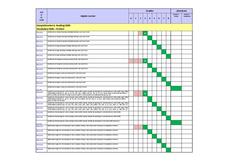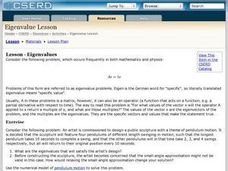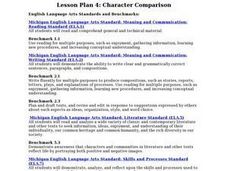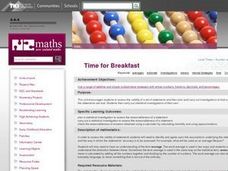Curated OER
Explain Your Vote!
Students improve their essay writing skills using the subject of voting as a topic. In this writing essays lesson, students write expository essays to increase the weight of their vote in the 'Cast Your Vote Poll' for the Trans-Amazon...
Curated OER
9th Grade Transition Algebra
Ninth graders examine mathematical patterns. In this algebra instructional activity, 9th graders collaborate to think outside the box and share solutions to problems they have encountered. Students use popsicle sticks to solve various...
Curated OER
Responses to Discrimination During the Civil Rights Period
Students examine the effects of discrimination. In this American Civil Rights Movement lesson, students participate in a classroom activity that requires them to personally feel the effects of discrimination. Students then explore...
Curated OER
Techniques Used to Convey Media Messages
Learners consider the impact of media messages. For this media awareness lesson, students discover the types of media techniques employed in advertising and share examples of each as they create media message collages.
Curated OER
How Do I Learn Best?
Students discover their learning styles. In this language arts lesson, students read about the various learning styles. Students determine their learning style and discuss how they can use this knowledge.
Curated OER
Numbers Make Sense
Second graders explore number values by completing estimation problems in class. In this place value lesson, 2nd graders identify the use of decimals in numbers and how they relate to fractions or parts of a whole. Students utilize flash...
Curated OER
Summarizing Key Information
Students summarize information. In this language arts lesson, students summarize information from a fictional text. Students read a folktale and summarize the story.
Curated OER
Writing Letters Using Appleworks
Young scholars discover how to write letters using Appleworks. Following a demonstration by the teacher, they compose rough drafts of their letters. Working independently, students correct their drafts and type the final versions.
Curated OER
Use synonyms to make your writing vivid
Students examine synonyms and practice finding appropriate synonyms in a thesaurus. For this use synonyms to make your writing vivid lesson, students identify the correct usage of synonyms. Students replace incorrect synonyms in...
Curated OER
Same, But Different
Young scholars compare and contrast specific characters in the book, "Old Henry." They discuss similarities and differences between people and define character traits. They assess one's own character traits and have a class discussion...
Curated OER
Ready Set Read!
Students practice a variety of techniques and strategies for mastering the skills for reading fluently with expression and emotion utilizing timed readings. They read and reread, "Arthur's Reading Race," by Marc Brown and "James and the...
Curated OER
Tell Me That You Love Me 5-7-5
Young scholars listen to several examples of Haiku poetry and discuss the strict format. Then students create and edit their own Haiku poems and enhance them with ink designs.
Curated OER
"You Shall Do Your Best Endeavor" - Working With Primary Documents
Students read and interpret primary source documents regarding historic Jamestown. In small groups, they read the primary documents, answer questions, and view online maps of Jamestown Island and Virginia.
Curated OER
There's a Writer Waiting Inside Me
Eighth graders are introduced to the concept, What Makes Good Poetry? They are asked to explore the writer within.
Curated OER
High in the Sky with Fluency
Students practice reading orally to increase speed and fluency in this lesson. The teacher models fluent reading by reading orally the book "Arthur's Reading Race." The students then work with a partner taking turns reading and...
Curated OER
Physics: Eigenvalues
Students solve problems by discovering the eigenvalues that satisfy design questions. They explain how relaxing a small angle approximation can change the solution. Students apply the numerical model of pendulumm motion to solve the...
Curated OER
Character Comparison: Tales of a Fourth Grade Nothing
Fourth graders compare and contrast Fudge and Peter, two main characters from "Tales of a Fourth Grade Nothing". They use a software template to analyze and compare the characters in a rough draft, edit their work and then produce a...
Curated OER
Commercials
Young scholars observe as the teacher demonstrates how to use a digital video camera. They experiment with the camera to get to know its features. Finally they create a video commercial and edit it, inserting sounds, titles and other...
Curated OER
Science Happens in a Social Context
Students discuss how the same data is viewed differently between historians and scientists. Using the data, they compare and contrast the vocabulary used and the focus of attention. They analyze the conditions that help spread diseases...
Curated OER
Fractional Blocks
Students explore the concept that fractions can also be considered a ratio. They discover that the fraction bar can be read as "out of." Students practice basic multiplication facts and use patterns to find fractions of shapes.
Curated OER
Introduction to Night by Elie Wiesel
Learners research background knowledge of the Holocaust using Internet websites and the video Seared Souls as preparation for reading Elie Wiesel's Night. For this Night lesson, students visit websites for Holocaust vocabulary,...
Curated OER
Time For Breakfast
This unit encourages students to assess the validity of a set of statements and then plan and carry out investigations to find out whether the statements are true. Students then carry out statistical investigations of their own.
Curated OER
The Perfect Man: Benjamin Franklin's Autobiography
Eleventh graders study the characteristics of an autobiography. They read from the autobiography of Benjamin Franklin and discuss and write an essay regarding some of his quotes.
Curated OER
Using News Broadcasts in Japan and the U.S as Cultural Lenses
High schoolers view archives of news broadcasts in order to create a context of cultural understanding. They compare and contrast the news broadcasts in Japan and the United States.






